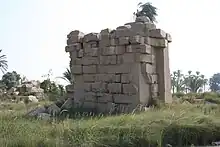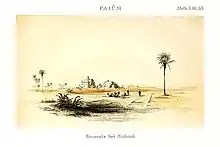
The Pedestals of Biahmu (also spelled Biyahmū)[1] are the basal remnants of two colossal statues erected by the ancient Egyptian pharaoh Amenemhat III. The ruins, which once stood on the shore of Lake Moeris, are located in the Faiyum Oasis 4 miles (6.4 km) north of the city Faiyum. The actual statues were long ago destroyed and only their bases have survived.[2]
Name
The pedestals are known by a variety of names, including the "Colossi of Biahmu"[3] and the "Pyramids of Biahmu".[4][5] Locally, they are often referred to as Al-Ṣanam (الصنـمـ), which is Arabic for "The Idol".[1][2] Historically, the ruins have also been called Haram Biyahmū ("Pyramid of Biahmu"), Rigl Pharaon ("The Foot of the Pharaoh"), and Mustuhamel ("The Bathed").[1]
History

The first mention of the statues can be found in the work of the Greek historian Herodotus (fl. 5th century BC),[4][2] who claims in his Histories that "in the centre [of Lake Moeris] there stand two pyramids, rising to the height of fifty fathoms above the surface of the water, and extending as far beneath, crowned each of them with a colossal statue sitting upon a throne."[6] Herodotus's claim that the statues towered "fifty fathoms" above the lake is almost certainly "grossly inflated".[7] Additionally, given the impracticality of building pyramids in water, the British Egyptologist William Matthew Flinders Petrie hypothesizes that Herodotus wrote of these statues during a time that the area had flooded.[4] Claims similar to those made by Herodotus were later repeated by Diodorus the Sicilian (fl. 1st century BC)[1][8] and Pliny the Elder (AD 23/24 – 79).[1][9]
In 1245, the Arabic writer Abu Osman el-Nabulsi el-Safadi reported that the tops of both statues had been partially destroyed in the search for supposed treasures.[2][10][11] In 1672,[12] the theologian Johann Michael Vansleb wrote that he could only make out the remains of one of the two statues,[2] and by the time the English travel writer Richard Pococke visited the site in 1737, only the bases remained.[5][7] In the 19th century, William Matthew Flinders Petrie studied the site,[4] as did Labib Habachi in the 1940s.[1] Habachi provided evidence that the statues had been raised by Amenemhat III, and Petrie argued that each were originally 60 feet (18 m) tall and surrounded by a courtyard with embanked walls. On the plinths were carved representations of the 42 nomes (territorial divisions) of ancient Egypt. The statues once stood on a causeway flanking Lake Moeris. Between them was a road that led to the ancient city of Arsinoe (i.e., Crocodilopolis).[4][1]
References
- 1 2 3 4 5 6 7 Habachi, Labib (1941). "The Monument of Biahmu". Annales du service des antiquités de l'Égypte. 40: 721–739. Retrieved October 4, 2022.
- 1 2 3 4 5 Hewison, R. Neil (2007). "Al-Ṣanam". Fayoum: History and Guide. Cairo: American University in Cairo Press. pp. 77–79. ISBN 978-1-936190-07-2.
- ↑ Haney, Lisa Saladino (2020). Visualizing Coregency: An Exploration of the Link between Royal Image and Co-Rule during the Reign of Senwosret III and Amenemhet III. Leiden, Netherlands: Brill Publishers. p. 384. ISBN 978-90-04-42215-5.
- 1 2 3 4 5 Petrie, William Matthew Flinders (1889). Hawara, Biahmu, and Arsinoe. London: Field & Tuer. Retrieved October 4, 2022.
- 1 2 Pococke, Richard (1743). A Description of the East, and Some Other Countries. Vol. 1. London: W. Boyer. pp. 57–58. Retrieved October 4, 2022.
There are particularly to the north of the village, ruins on each side of the road, which I found to be of two pyramids ... They are called by the people the pyramids of Baiamout (Al-Harem-Baiamout).
- ↑ Herodotus, Histories, 2.149. (Translation from The History of Herodotus. Vol. 2. Translated by Rawlinson, George. London: John Murray. 1859. pp. 195–196. Retrieved October 4, 2022.)
- 1 2 Lloyd, Alan B. (1975). Herodotus: Book II Commentary 99-182. Leiden, Netherlands: Brill Publishers. p. 126. ISBN 978-90-04-07737-9.
- ↑ Diodorus the Sicilian, Bibliotheca historica, 2.52. "The king ... left a spot in the centre [of the lake], where he built a tomb and two pyramids." (Translation from The Library of History of Diodorus Siculus. Loeb Classical Library. Translated by Oldfather, Charles Henry. Cambridge, MA: Harvard University Press. 1933. pp. 184–185.)
- ↑ Pliny the Elder, Naturalis historia, 36.16. "[There are] two [pyramids] in the place where Lake Moeris was excavated [and] the summits of the pyramids, it is said, are to be seen above the water." (Translation from "Chap. 16. (12.)—Marvellous Works in Egypt. The Pyramids". Perseus Project. Translated by Bostock, John; Riley, H.T. Tufts University. 1855. Retrieved October 4, 2022.)
- ↑ Abu Osman el-Nabulsi el-Safadi el-Safi (1887). Mortiz, B. (ed.). The History of the Fayoum and Its Towns. Cairo, Egypt: National Press of Cairo.
- ↑ Haney, Lisa Saladino (2020). Visualizing Coregency: An Exploration of the Link between Royal Image and Co-Rule during the Reign of Senwosret III and Amenemhet III. Leiden, Netherlands: Brill Publishers. p. 270. ISBN 978-90-04-42215-5.
- ↑ Vansleb, Johann Michael (1677). Nouvelle relation en forme de journal d'un voyage fait en Égypte par le P. Vansleb,... en 1672 et 1673 (in French). Paris, France: Estienne Michallet. p. 260. Retrieved October 4, 2022.
Je fus à Biiamúh ... pout voir ... le tronc d'une Statuë de Geant ... sans teste, & sans bras, posésur un pied-d'estail.
[I went to Biahmu ... to see ... the torso of a Statue of a Giant positioned on a pedestal; it is ... missing its head and arms.]